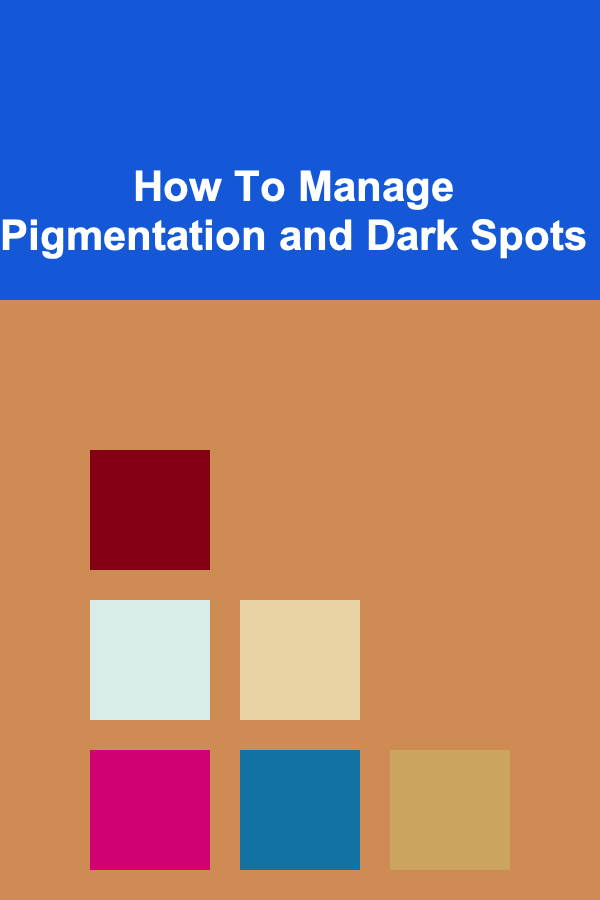
How To Manage Pigmentation and Dark Spots
ebook include PDF & Audio bundle (Micro Guide)
$12.99$10.99
Limited Time Offer! Order within the next:

Pigmentation and dark spots, often referred to as hyperpigmentation, are common skin concerns that affect people of all skin types and tones. Whether caused by sun exposure, hormonal changes, acne scars, or aging, these dark patches can be a source of frustration. Fortunately, there are numerous effective treatments, remedies, and strategies to manage and reduce the appearance of pigmentation and dark spots. In this article, we will explore the causes, prevention methods, and treatments available to help you manage pigmentation and dark spots.
Understanding Pigmentation and Dark Spots
What is Pigmentation?
Pigmentation refers to the color of the skin, which is determined by the presence of a pigment called melanin. Melanin is produced by cells called melanocytes, which are located in the skin's epidermis. The amount and type of melanin in the skin give it its color, and this process is influenced by genetic factors, sun exposure, and other environmental triggers.
When melanocytes produce excessive melanin, it leads to darker patches on the skin, resulting in pigmentation. Pigmentation can occur in various forms, such as age spots, melasma, post-inflammatory hyperpigmentation, and freckles.
Types of Dark Spots
Dark spots can appear for a variety of reasons, but they all share the common trait of being darker than the surrounding skin. These spots typically result from an overproduction of melanin. The most common types of dark spots include:
1. Sunspots (Liver Spots or Age Spots)
Sunspots, also known as liver spots or age spots, are the most common type of pigmentation. These spots develop due to prolonged sun exposure over time and are often found on the face, hands, shoulders, and arms.
2. Melasma
Melasma, often referred to as the "mask of pregnancy," is a form of hyperpigmentation that appears as brown or grayish patches, typically on the face. It is common among pregnant women due to hormonal fluctuations but can affect anyone.
3. Post-Inflammatory Hyperpigmentation (PIH)
This type of pigmentation occurs after an injury or inflammation, such as acne, cuts, or burns. PIH manifests as dark spots or scars left behind after the skin heals.
4. Freckles
Freckles are small, light brown spots that are usually genetic and become more prominent with sun exposure. They are commonly found on the face and arms.
Causes of Dark Spots and Pigmentation
Pigmentation and dark spots occur due to an overproduction of melanin. Here are the main causes:
1. Sun Exposure
Prolonged exposure to ultraviolet (UV) rays from the sun stimulates the skin to produce more melanin, leading to dark spots. Sunspots or age spots are most commonly seen in individuals with a history of sun exposure.
2. Hormonal Changes
Hormonal fluctuations, especially during pregnancy or the use of birth control, can cause melasma. This condition is often triggered by hormonal changes that increase melanin production.
3. Acne Scars
Acne can leave behind dark spots after the inflammation heals. These post-inflammatory marks are particularly common among people with darker skin tones.
4. Genetics
Some individuals are genetically predisposed to pigmentation issues. If your family members have a tendency to develop freckles or other types of pigmentation, you may also be more likely to experience them.
5. Aging
As we age, the skin undergoes various changes, including the development of age spots or sunspots due to years of accumulated sun exposure. These spots are typically harmless but may become more noticeable over time.
6. Skin Inflammation and Injury
Any form of trauma to the skin, whether from a cut, burn, or insect bite, can result in post-inflammatory hyperpigmentation as the skin heals.
Preventing Pigmentation and Dark Spots
Prevention is always better than treatment, especially when it comes to pigmentation. Here are some proactive measures to prevent the development of dark spots:
1. Sun Protection
The most effective way to prevent pigmentation is to protect your skin from the sun. Always apply a broad-spectrum sunscreen with an SPF of at least 30 every morning, even on cloudy days. Sunscreen helps to protect the skin from harmful UV rays that trigger melanin production.
- Reapply sunscreen every two hours, especially if you're outdoors or sweating.
- Wear protective clothing such as hats, sunglasses, and long sleeves to minimize sun exposure.
- Avoid peak sun hours (10 a.m. to 4 p.m.) when UV rays are the strongest.
2. Avoid Skin Trauma
Avoid picking at your skin, especially acne, which can leave dark spots behind. If you have acne, use proper treatments that minimize inflammation and prevent scarring.
3. Hormonal Management
If you are prone to melasma due to hormonal fluctuations, consult with your healthcare provider about managing your hormones through medication, topical treatments, or lifestyle changes.
4. Moisturization
Keeping your skin hydrated is crucial for overall skin health. Dry skin can become more prone to irritation and inflammation, which can lead to pigmentation issues. Use a good moisturizer suited for your skin type.
5. Healthy Diet
A balanced diet rich in antioxidants can support your skin health. Foods high in vitamins A, C, and E, such as fruits, vegetables, and nuts, help promote collagen production and protect against skin damage.
Treatment Options for Managing Pigmentation and Dark Spots
While preventing pigmentation is essential, it is often not always possible to avoid dark spots altogether. Fortunately, several treatments can help lighten and manage pigmentation. These options vary depending on the cause, severity, and location of the dark spots.
1. Topical Treatments
1.1 Hydroquinone
Hydroquinone is one of the most commonly used treatments for hyperpigmentation. It works by inhibiting the enzyme responsible for melanin production, leading to a lightening of dark spots. Hydroquinone is available in both over-the-counter and prescription forms, depending on its concentration.
- How to Use: Apply a thin layer to the affected area once or twice daily.
- Side Effects: Long-term use of hydroquinone may cause skin irritation or ochronosis (a blue-black discoloration of the skin), so it's important to follow your dermatologist's guidance.
1.2 Retinoids (Retinol)
Retinoids, such as tretinoin, are vitamin A derivatives that promote cell turnover and collagen production. By accelerating skin renewal, retinoids can help fade dark spots and improve overall skin texture.
- How to Use: Start with a lower concentration of retinol and gradually increase to prevent irritation. Apply at night to clean, dry skin.
- Side Effects: Retinoids can cause dryness, redness, and peeling, especially in the initial stages of use.
1.3 Vitamin C
Vitamin C is a potent antioxidant that brightens the skin and reduces pigmentation. It inhibits melanin production and helps fade dark spots over time.
- How to Use: Use a vitamin C serum in the morning, after cleansing and before applying sunscreen.
- Side Effects: Vitamin C is generally well-tolerated, but some people may experience irritation. It's best to patch-test new products.
1.4 Alpha Hydroxy Acids (AHAs)
AHAs, such as glycolic acid, exfoliate the top layer of dead skin cells and promote cell turnover. This can help fade dark spots by removing the buildup of pigmented cells.
- How to Use: Use an AHA serum or toner after cleansing. Start with a low concentration and gradually increase as your skin builds tolerance.
- Side Effects: AHAs can cause skin irritation, so always follow with sunscreen when using AHAs.
2. Professional Treatments
2.1 Chemical Peels
A chemical peel involves applying a chemical solution to the skin to exfoliate the outer layers. This procedure helps to lighten pigmentation and promote healthier, more even-toned skin.
- Frequency: Depending on the strength of the peel, treatments are typically spaced 4--6 weeks apart.
- Side Effects: Mild redness, peeling, and irritation can occur, but these side effects are temporary.
2.2 Laser Treatments
Laser treatments, such as fractional CO2 laser and intense pulsed light (IPL), target dark spots and pigmentation by breaking down the excess melanin in the skin.
- How it Works: Lasers use focused light to break up pigment particles, which are then absorbed by the body.
- Side Effects: Post-treatment redness, swelling, and potential hyperpigmentation can occur, but these side effects usually subside within a few days.
2.3 Microneedling
Microneedling involves using tiny needles to create micro-injuries in the skin, stimulating collagen production and promoting skin regeneration. This treatment can help reduce pigmentation and improve skin texture.
- How it Works: The micro-injuries encourage skin healing and regeneration, leading to the fading of dark spots over time.
- Side Effects: Redness, swelling, and mild irritation may occur, but these effects generally subside within a few days.
3. Natural Remedies
For those who prefer a more natural approach, several remedies may help lighten pigmentation over time:
3.1 Aloe Vera
Aloe vera contains aloesin, a compound that can help lighten dark spots. Applying fresh aloe vera gel to the skin may reduce the appearance of pigmentation.
- How to Use: Apply aloe vera gel to the affected area at night and leave it on overnight.
3.2 Lemon Juice
Lemon juice is known for its natural bleaching properties. It can help lighten dark spots when used consistently.
- How to Use: Dilute lemon juice with water and apply it to dark spots using a cotton ball. Be cautious with lemon juice, as it can make the skin more sensitive to the sun.
3.3 Turmeric
Turmeric has anti-inflammatory and skin-brightening properties. It can be used in DIY face masks to reduce pigmentation.
- How to Use: Mix turmeric powder with honey or yogurt to form a paste and apply to the affected area for 15--20 minutes.
Conclusion
Managing pigmentation and dark spots requires a combination of prevention, topical treatments, and professional interventions. By following a consistent skincare routine that includes sun protection, exfoliation, and the use of brightening products, you can effectively lighten and reduce dark spots. Additionally, professional treatments such as chemical peels, laser therapies, and microneedling can provide more dramatic results.
It's essential to be patient when addressing pigmentation concerns, as improvements take time. Always consult with a dermatologist before starting any new treatments, especially if you have sensitive skin or existing skin conditions. With the right approach, managing pigmentation and dark spots can become a manageable part of your skincare journey, leading to clearer, more even-toned skin.

A Complete Guide to Utilizing Free or Discounted Public Transportation Programs
Read More
Affordable Alternative Transportation Options for a Greener Commute
Read More
How to Introduce a New Pet to Your Home and Other Animals
Read More
How to Keep Your Pet's Teeth Clean and Healthy
Read More
How to Use LinkedIn Insights to Tailor Your B2B Dropshipping Marketing Strategy
Read More
Crafting Engaging Middle Sections of Your Story
Read MoreOther Products

A Complete Guide to Utilizing Free or Discounted Public Transportation Programs
Read More
Affordable Alternative Transportation Options for a Greener Commute
Read More
How to Introduce a New Pet to Your Home and Other Animals
Read More
How to Keep Your Pet's Teeth Clean and Healthy
Read More
How to Use LinkedIn Insights to Tailor Your B2B Dropshipping Marketing Strategy
Read More